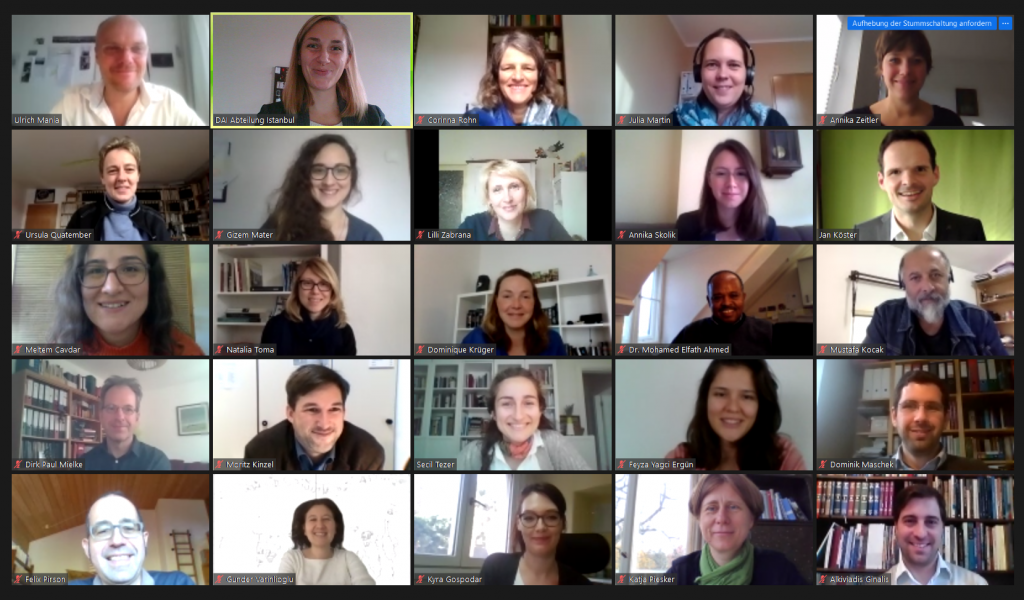Constitutional Meeting of the 6th Research Network at DAI Istanbul
Research Networks at the Istanbul department of the DAI can look back on a long tradition. Established in 2007, they aim to bring together preferably young researchers under the umbrella of a specific research topic. Over a period of up to three years, a fixed group of participants gathers for a couple of meetings to discuss and exchange among each other or with invited speakers. On Friday and Saturday, November 13th and 14th 2020,the first meeting of the new Research Network “Building, Building Economy, Building Sites” took place. The constitutional meeting was originally planned for March but had to be cancelled due to the COVID-19 pandemic. After a busy summer we tried a second go with a virtual meeting. The aim of it was to introduce ourselves and our respective research projects in short presentations. This was followed by a broad discussion to prepare the four or five future meetings of the Network. Thanks to the organisational work and the support of our IT department everything went smoothly and the opportunity to distribute the conference participants in smaller groups enabled intensive conversation as preparation for a final discussion on, amongst other things, the determination of the future meetings’ topics.

As for the content of the Network, the sessions started with short papers on the topic of resources for building projects during the Roman imperial period and beyond. Quarrying, origin of materials, and spoliation were keywords of the contributions (U. Mania, G. Mater, N. Toma, G. Varınlıoğlu, L. Zabrana).
In the second session the topic “techniques” was addressed by the speakers (M. Çavdar, A. Ginalis, A. Schachner, A. Skolik, J. R. Snyder, F. Yağcı). Here, the timeframe reached from Prehistoric up to Late Ottoman times and the foci of the papers were put on origin and placing of stones, principles of the construction of ancient dwellings, the use and composition of mortars, and the decision-making on the application of certain building techniques.
In the session on “building sites”, topics like logistics, transportation, the recycling of former building phases as well as the introduction of new building material such as brick were key themes. The even broader timespan was covered by M. E. Ahmed, K. Gospodar, M. Kinzel, M. Koçak and J. Martin.
In the “monuments” session, certain buildings or building projects like monumental Hittite architecture or the Octagon of Pergamon were presented. Further topics were the specifics of Roman building in Boğazköy and temple architecture in Pergamon (S. Tezer Altay, D. Krüger, D. P. Mielke, A. Zeitler).
In the final session we tried to put together projects with a more general approach like the shaping of landscapes by building, architectural documentation as precondition for the understanding and establishing of research on building in Asia Minor as a scientific subject, building in peripheries, and data processing and visualisation (R. Braun, J. Köster, D. Maschek, N. Neuenfeld, C. Rohn, U. Quatember).
The second day started with a keynote lecture on construction industry in Roman Asia Minor by U. Mania. This provided an ideal framework and overview of the vast and complex topic of building and the economy behind it. The lecture was eventually followed by the intensive group discussions. The constitutional meeting was finalized by a plenary session, which intended to sum up the research topics discussed during the individual group discussions. At the end, future Network sessions were successfully planned. The topic of the following session, which will be held on March 5th and 6th 2021 will be “The Human Factor in Construction Economy”. This comprises papers dedicated to the themes “resources, craftsmanship, traditions and connectivity as factors of local building”, “work force: realisation of building projects”, “project development and construction (including institutions and other agents)”, and “consequences of choosing a construction site (especially local aspects)”.
Future sessions in 2021 and 2022 will be dealing with Resources (including themes like “quantifying resources: from extraction to construction sites”, “resources and local economies”, “buildings as resources of building material”, and “provenance: local influences vs. imports”), Aspects of Continuity, including the maintenance, repairs, abandonment, and demolitions of buildings, and finally Construction and Social Ecology, which will focus on building/construction in a socio-political context or on the question of how to reconstruct/visualise building processes.
Many thanks to all contributors and organisers of the first constitutional meeting of this 6th Research Network and let’s hope that we will see each other soon again. Until then, stay healthy!
